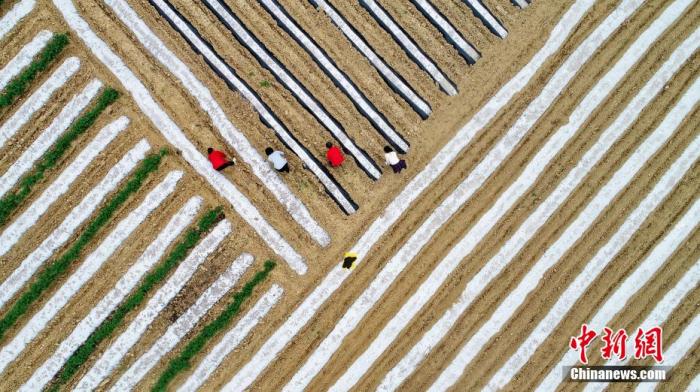China News Service, August 26. Wang Guanghua, member of the Party Leadership Group and Deputy Minister of the Ministry of Natural Resources, and Director of the Office of the Third National Land Survey Leading Group of the State Council, said on the 26th that the results of the "three adjustments" showed that the country’s arable land was 1.918 billion mu at the end of 2019. At the national level, the target for the amount of cultivated land set in the plan has been achieved.
Data map: Farmers rushed to catch the sunny weather and busy spring ploughing.
Photo by Yuan Xuanguo
On the 26th, a press conference on the main data results of the third national land survey was held.
At the meeting, a reporter asked: Judging from the "third adjustment" data, the country has 1.918 billion mu of arable land, which has been reduced by 113 million mu in the 10 years since the "second adjustment". What measures will be taken next to protect 1.8 billion mu? Cultivated land red line?
In this regard, Wang Guanghua said that the Party Central Committee and the State Council have always attached great importance to the protection of cultivated land.
In 2017, the "Outline of National Land Planning (2016-2030)" issued by the State Council, in accordance with the overall requirements of ensuring national food security, coordinated and balanced the support of economic and social development, poverty alleviation, agricultural structural adjustment and ecological construction, and established 2020. The arable land retention target in 2030 is 1.865 billion mu and 1.825 billion mu respectively.
The results of the "Three Adjustments" showed that by the end of 2019, the country's cultivated land was 1.918 billion mu. From a national perspective, the target for the amount of cultivated land set in the plan was achieved.
Wang Guanghua pointed out that from the “third adjustment” data, in the 10 years since the “second adjustment”, the country’s arable land has decreased by 113 million mu. Under the condition that the non-agricultural construction occupation of arable land has strictly implemented the balance of occupation and compensation, the arable land has decreased. The main reason is the adjustment of agricultural structure and land greening.
In the land conversion of the past 10 years, there have been cases where cultivated land flows to forest land and garden land, and there are also cases of forest land and garden land flowing to cultivated land. As a result, the net flow of cultivated land to forest land is 112 million mu, and the net flow to garden land is 63 million mu.
Wang Guanghua said that some of the cultivated land flowing to garden land and other agricultural land destroyed the cultivated layer, and some did not. The "Three Adjustments" specifically investigated and marked this. There are more than 87 million acres of agricultural land that can be restored to cultivated land across the country. There are also 166 million mu of agricultural land that can be restored to cultivated land through engineering measures. If necessary, this part of agricultural land can be restored to cultivated land through corresponding measures, but at economic and social costs.
Therefore, as long as we make overall arrangements and strict management and control, the red line of 1.8 billion acres of arable land can be maintained.
But we must not take it lightly, we must adhere to the strictest farmland protection system and keep the farmland red line firmly.
First, combining with the compilation of territorial and spatial planning at all levels, using the results of the "three adjustments" as the base and base map, and in accordance with the principle of ensuring that all should be preserved, the target for the amount of cultivated land in various regions shall be reasonably determined, the permanent basic farmland shall be strictly delineated, and 1.8 billion yuan shall be firmly secured. Red line for acres of arable land.
The second is to establish and improve the responsibility assessment mechanism for cultivated land protection targets, and consolidate the responsibility of local party committees and governments at all levels for cultivated land protection targets.
Decompose and assign arable land retention and permanent basic farmland protection tasks step by step with location, sign responsibility letters for arable land protection targets, implement rigid index assessments, and share the responsibility of the party and government.
The National Natural Resources Inspectorate will further strengthen supervision, and shall seriously hold accountable for those who do not comply with orders, prohibitions, or neglect their duties in the protection of cultivated land.
The third is to implement special protection for arable land, especially permanent basic farmland.
Cultivated land is mainly used for the production of grain and agricultural products such as cotton, oil, sugar, and vegetables. Permanent basic farmland is managed as grain field.
Strict use control, resolutely curb the "non-agriculturalization" of cultivated land, and strictly control the "non-grainization" of cultivated land.
Strictly control the conversion of cultivated land into forest land, grassland, garden land and other agricultural land.
Fourth, on the basis of the preliminary evaluation of the "three adjustments", various regions are being organized to carry out demonstrations of the suitability of cultivated land development on a block-by-block basis, to determine the reserve resources of cultivated land that can be developed, and to rationally arrange reclamation.
Fifth, standardize and improve the balance of arable land occupation and supplement, strictly check the quality of supplementary arable land, map and store all supplementary arable land block by block, and openly accept the supervision of the whole society to ensure that the supplement arable land is equal in quantity and quality.
In the past three years, three comprehensive inspections of the balance of occupation and compensation have been organized. At present, more than 17,000 supplementary arable land projects and plots of information have been published to the whole society on the Ministry’s portal, and will continue to be announced in the future.

